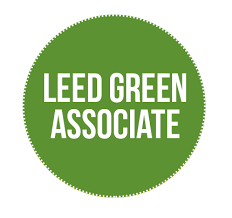
Overview
Looking to advance or start a career in the rapidly growing field of Green Building? LEED is the world’s most widely used green building rating system. The LEED Green Associate is the first of two levels of professional green building accreditation developed by the US Green Building Council (USGBC). LEED Green associates, also known as “LEED GAs,” have demonstrated knowledge of green building practices and standards related to building design, construction, use, and maintenance.
Benefits of becoming a LEED green associate?
A LEED GA can help anybody who works in commercial real estate or wishes to work in a connected area. LEED experts are in high demand, whether you are a college student trying to stand out from the crowd of fresh grads or a seasoned professional looking to broaden your knowledge and project or career possibilities. Green Associates are typically seen in the following roles:
- College Student
- Engineers
- Architects
- Contractors in general
- Professionals in Real Estate
- Planners of Cities and Neighborhoods
- Designers of Interiors
- Managers of Real Estate
- Maintenance Personnel
- Superintendents of Construction
Where can I find out how to become a LEED green associate?
The Green Associate credential is obtained by passing the Green Business Certification Inc.’s 100-question LEED Green Associate exam (GBCI). LEED GA is required for the following level: LEED Accredited Professional, abbreviated as LEED AP.
What is the difficulty level of the LEED green associate exam?
What the LEED GA exam lacks in mathematical and technical difficulty, it more than makes up for in depth of subject matter. In other words, as evidenced by the massive 800+ page rating system guides, it requires you to know a little bit about a lot. When you know what topics to study, the exam becomes less intimidating.
- You will save time (study a fraction of the time vs. reading the complete LEED reference guide or learning about all of the LEED rating systems)
- Concentrating on the exam material (rather than all the extraneous information you don’t need to know to pass)
- Providing practice tests that are nearly identical in style to the actual test questions, as well as detailed explanations of the correct answers.
How long does the green associate credential last?
All LEED certificates are valid indefinitely if they are renewed every two years through continuing education. This guarantees that professionals are up to date on this ever-changing building standard. Every two years, the LEED Green Associate will need to complete 15 hours of continuing education.
Prior to testing, GBCI suggests that you gain knowledge of LEED and green building concepts through educational courses, volunteer activities, or work experience.
You must meet the following requirements to be eligible for the LEED Green Associate credential:
- If you are under the age of 18, have your parent or guardian sign the Parental Consent form on your behalf.
- Accept the Disciplinary and Exam Appeals Policy and the conditions for credential maintenance.
The LEED Green Associate test is graded on a scale of 125 to 200. To pass, you must have a score of 170 or above. At the end of the exam, your exam score is displayed on the screen, and a score report is emailed to you.
The following outline provides a general description of the LEED Green Associate exam content areas.
Knowledge Domains reflect the credit categories of rating systems and what one has to know as a LEED Green Associate.
The LEED Green Associate exam tests your broad knowledge of green building methods for commercial and residential structures, residential spaces, new and existing buildings, and how to collaborate with other professionals on LEED projects.
EXAM FORMAT
Total Question | 100 |
Duration | 2 Hours |
Format | Multiple Choice |
Languages Available | English, Arabic, Brazilian Portuguese, Chinese, French, German, Japanese, Korean, Spanish. |
Choose Your Preferred Learning Mode

1-TO-1 TRAINING
Customized schedule Learn at your dedicated hour Instant clarification of doubt Guaranteed to run
ONLINE TRAINING
Flexibility, Convenience & Time Saving More Effective Learning Cost Savings


CORPORATE TRAINING
Anytime – Across The Globe Hire A Trainer At Your Own Pace Customized Corporate Training
Domains of Knowledge
- Organizational fundamentals (for example, mission/vision, non-profit status, and the role of USGBC/GBCI)
- LEED rating system structure (e.g., credit categories; qualifications; credits and/or Minimum Program LEED certification requirements)
- Impact categories (for example, what should a LEED project achieve?)
- LEED certification procedure (e.g., certification levels [Certified, Silver, Gold, Platinum]; LEED Scorecard; third party verification; paperwork submission function; LEED interpretations; addenda; understanding of various system versions (e.g., LEED Online; LEED Online and Project Registration components)
- Other rating systems (e.g., what other rating systems are available in general)
- Process of Integration (e.g., early analysis of the interrelationships among systems; systems thinking; charrettes)
- Integrative project team members (for example, architect; engineer; landscape architect; civil engineer; contractor; manager of a facility, etc.)
- LEED-compliant standards (for example, the American Society of Heating, Refrigeration, and Air Conditioning) ASHRAE (American Society of Heating, Refrigeration, and Air Conditioning Engineers); Sheet Metal and Air Conditioning Contractors National Association [SMACNA] guidelines; Green Seal; ENERGY STAR®; HERs; ACP Reference Standards, etc.)
- Site selection (for example, prioritizing already developed and brownfields/high-priority designated areas; avoiding fragile habitat; situated in regions with existing infrastructure and local usage; parking reduction footprint)
- Alternative modes of transportation (e.g., type, access and quality; infrastructure and design)
- Site evaluation (e.g., environmental assessment; human impact)
- Site design and development (for example, building activity pollution prevention, habitat conservation, outdoor open space restoration; rainwater management; exterior lighting; heat island reduction)
- Outdoor water use (e.g., irrigation with graywater/rainwater; utilization of native and adaptable plants)
- Indoor water use (e.g., low flow/waterless fixture designs; water-efficient appliances; kinds and quality)
- Management of water performance (e.g., measurement and monitoring)
- Construction loads (e.g., building components; space usage [private office, individual space, shared multi-occupant spaces)
- Energy efficiency (e.g., basic design concepts; operational energy efficiency; commissioning; energy management auditing)
- Alternative and renewable energy strategies (for example, demand response; renewable energy; green power; carbon capture and storage offsets)
- Energy performance management (for example, energy usage measurement and monitoring; building automation control systems/advanced energy metering; operations and management; benchmarking; ENERGY STAR)
- Environmental problems (e.g., energy sources and resources; greenhouse emissions; possibility for global warming; loss of resources; ozone depletion)
- Reusing (e.g., building reuse; material reuse; interior reuse; furniture reuse)
- Life-cycle implications (e.g., life-cycle assessment concept; material qualities; human and ecological health impact; design for adaptability)
- Waste (for example, construction and demolition; maintenance and renovation; ongoing operations and waste management strategy)
- Purchases and statements (for example, purchasing programmes and goals; environmentally preferred purchasing (EPP); disclosure and optimization of building products [i.e., raw material sourcing, material constituents, etc. Disclosure of environmental products)
- Indoor air quality (for example, ventilation levels; tobacco smoke control; monitoring and improvement of indoor air quality; low-emitting materials; environmentally friendly cleaning)
- Lights (e.g., electric lighting quality; daylight)
- Audio (e.g., acoustics)
- Occupant comfort, health, and satisfaction (e.g., system controllability; thermal comfort design; product quality opinions; evaluation/survey)
- The importance of green buildings; environmental externalities; and the triple bottom line)
- Sustainable design values (e.g., energy savings over time; healthier occupants; money-saving incentives; costs (both hard and soft costs; life cycle)
- Regional design (e.g., regional green design and building measures as needed; regional emphasis should be included in the Sustainable Sites and Materials & Resources sections)
Get In TOUCH
Frequently Asked Questions

Individuals who have a verified, up-to-date understanding of the most recent green building concepts and practises are designated as LEED Green Associates.
While green certifications such as LEED have become fashionable marketing tools, they do have some tangible advantages: – Green home owners save 25% on their annual energy bills, according to data.
Associate Salary at LEED Green
Annual Salary | Hourly Wage |
Top Earners | $106,000 |
75th Percentile | $90,000 |
Average | $60,789 |
25th Percentile | $31,000 |
All LEED certifications are valid for life if they are renewed every two years with continuing education. This guarantees that professionals are up to date on this ever-changing building standard. Every two years, the LEED Green Associate will be required to complete 15 hours of continuing education.
It can be difficult to know what to study for the LEED Green Associate exam. There is a wealth of knowledge available, ranging from the highly technical to the very broad. You can take the quiz to see where you stand or as a study tool in and of itself.
